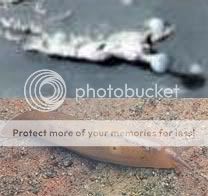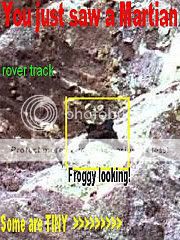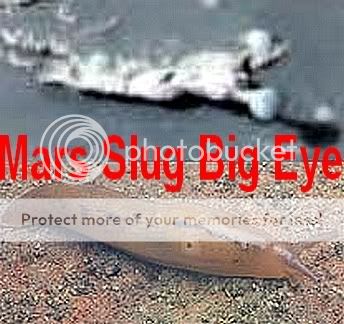It looks like you're using an Ad Blocker.
Please white-list or disable AboveTopSecret.com in your ad-blocking tool.
Thank you.
Some features of ATS will be disabled while you continue to use an ad-blocker.
share:
Originally posted by mikesingh
But here's something interesting. Some of these little spherules when seen in infra red are reddish in colour!
That doesnt make any sense to be honest, since most of the red things are clearly NOT spheres. Comparing with the regular image, its a quite simple translation: The brighter the stone (or whatever they are) the more red it is.
Been There ...Done That...
They are hematite nodules... and they cover an area the size of Oklahoma... good source of iron ore for building Mars bases
Oh yeah and it means there was a LOT of water on Mars once upon a time...
BLUE BERRIES MILLION OF EM!!
MORE AND MORE BLUEBERRIES
Now then what happened to all that water? Simple! Someone opened a Stargate at the bottom of the Martian Ocean and it all went to Earth...
I mean just where did you THINK the flood came from?
:shk: :bash:
They are hematite nodules... and they cover an area the size of Oklahoma... good source of iron ore for building Mars bases
Oh yeah and it means there was a LOT of water on Mars once upon a time...
BLUE BERRIES MILLION OF EM!!
MORE AND MORE BLUEBERRIES
Now then what happened to all that water? Simple! Someone opened a Stargate at the bottom of the Martian Ocean and it all went to Earth...
I mean just where did you THINK the flood came from?
:shk: :bash:
Originally posted by zorgon
Been There ...Done That...
They are hematite nodules... and they cover an area the size of Oklahoma... good source of iron ore for building Mars bases
Oh yeah and it means there was a LOT of water on Mars once upon a time...
Darn right Zorgon!
“On Earth, whenever we find water, we find life – in surface water or underground water, hot water or cold water – any place there is water on Earth there are microbes, there is life.” “That’s the bottom line: hematite is linked to life.”
- Bill Parry
So Hematite = water=life???? Now we're getting closer to the truth that water was abundant on Mars! And therefore life! Cheers!!
Originally posted by mikesingh
And therefore life! Cheers!!
Blood has hematite in it hence hemoglobin
Speaking about life hear about the Nanobacteria all the Astronauts picked up? So far they appear harmless... but they got em
Originally posted by merka
Originally posted by mikesingh
But here's something interesting. Some of these little spherules when seen in infra red are reddish in colour!
That doesn't make any sense to be honest, since most of the red things are clearly NOT spheres. Comparing with the regular image, its a quite simple translation: The brighter the stone (or whatever they are) the more red it is.
What's that again? First, I thought I said SOME of the spherules, which means globular. They need not be perfect spheres. Spherules is only a generic term. But that's digressing from the point.
Second, your translation is not all that simple as you suggest. If you're clued up on IR thermal imaging systems, then you'll be aware that black and white, and color, are properties of visible light that do not exist in the infrared world.
Because we need to convert these images into visible light, the IR camera assigns black to the coolest temperatures in an image, white to the hottest temperatures in an image, and graduating shades of gray in between. Similarly, different colors can be used to portray different temperatures.
Get the idea? So that's what I meant!
Cheers!!
Originally posted by mikesingh
are reddish in colour!
Them red ones is Raspberries...
and the IR pictures are showing what NASA in their infinite brilliance at naming things has called "popcorn" They are white and are a little more lumpy that the blueberries and would show "warmer" as they are not iron, but most likely calcite or dolomite spheres that have replaced washed out hematites...
Oh yeah that also requires water LOL
Anyone see the fossils on Mars ?
The picture may or may not be Mushrooms.....I would go with the not.
Yet, if you look into Fungi, they probably could very well live on Mars. They need oxygen, Co2 and a little H20. They can live in complete darkness and gain energy off of radiation.
If you look at some ideas of "day after" scenario's fungi are speculated to be the organism that may bring life back to a planet.www.bioneers.org...
Also..www.astrobio.net...
Yet, if you look into Fungi, they probably could very well live on Mars. They need oxygen, Co2 and a little H20. They can live in complete darkness and gain energy off of radiation.
If you look at some ideas of "day after" scenario's fungi are speculated to be the organism that may bring life back to a planet.www.bioneers.org...
Also..www.astrobio.net...
I'm leaning toward sediments of some sort, but I wouldn't be too surprised if it's some kind of alien fungus.
Source.
Hematite is one of few minerals found on Mars
that can be linked directly to water-related processes.
The potential role of biomediation in the precipitation
of some terrestrial hematite concretions can hold
important clues in the search for extraterrestrial life.
The study of the terrestrial analogs will increase our
insight to understanding fluid flow history and the
possibilities of life on Mars.
Source.
Early this year, scientists announced the discovery of tiny, spherical grains of hematite, a type of iron oxide, in some Martian sediments. Those spherules were dubbed blueberries because their distribution within the sediments reminded one of the scientists of blueberries in a muffin. The hematite blueberries provided one of several lines of evidence that suggest water once flowed on the Red Planet (SN: 3/6/04,p. 147). Although many of the Martian blueberries examined by NASA's Opportunity rover were still embedded in rocks, erosion had freed others.
The same type of iron oxide concretions form within some Utah sandstones, says Marjorie A. Chan, a geologist at the University of Utah in Salt Lake City. These terrestrial nodules come in spherical, ovoid, and lumpy shapes and can measure 20 centimeters or more across, while their Martian analogues are typically spherical and range up to only 5 millimeters in diameter.
Far more boring, but probably true.
As an interesting side-note; I had a box of these I picked up as a child. I gave one to a Geology Prof in a class in the early 70's and he could not identify it
We called them Flintstone Marbles. Not nearly as good to eat as mushrooms though.
Here is a picture of the ones from Utah and another pic from Mars.


I probably picked up many hundreds of these from very small to fist sized. The little ones made great Wrist-Rocket ammo.


I probably picked up many hundreds of these from very small to fist sized. The little ones made great Wrist-Rocket ammo.



new topics
-
North Korea in Ukraine conflict???
World War Three: 2 minutes ago -
Most Complex Backyard Rube Goldberg Machine You'll See All Day
General Chit Chat: 1 hours ago
top topics
-
Of course it was DEI
Dissecting Disinformation: 13 hours ago, 10 flags -
Most Complex Backyard Rube Goldberg Machine You'll See All Day
General Chit Chat: 1 hours ago, 4 flags -
2nd Day Thanksgiving!...(leftovers!!)
General Chit Chat: 15 hours ago, 3 flags -
North Korea in Ukraine conflict???
World War Three: 2 minutes ago, 0 flags
active topics
-
North Korea in Ukraine conflict???
World War Three • 0 • : Flyingclaydisk -
Post A Funny (T&C Friendly) Pic Part IV: The LOL awakens!
General Chit Chat • 7851 • : underpass61 -
Most Complex Backyard Rube Goldberg Machine You'll See All Day
General Chit Chat • 4 • : CarlLaFong -
I thought Trump was the existential threat?
World War Three • 128 • : JadedGhost -
Of course it was DEI
Dissecting Disinformation • 13 • : network dude -
population madness
New World Order • 21 • : Xtrozero -
V.P. Kamala Harris releases a video and nobody understands why
US Political Madness • 103 • : Xtrozero -
Mass UAP events. DC. Machester Airport, UFOs over sub base in CT, Nuke bases.
Aliens and UFOs • 31 • : alldaylong -
Encouraging News Media to be MAGA-PAF Should Be a Top Priority for Trump Admin 2025-2029.
Education and Media • 83 • : fringeofthefringe -
-@TH3WH17ERABB17- -Q- ---TIME TO SHOW THE WORLD--- -Part- --44--
Dissecting Disinformation • 3418 • : fringeofthefringe
